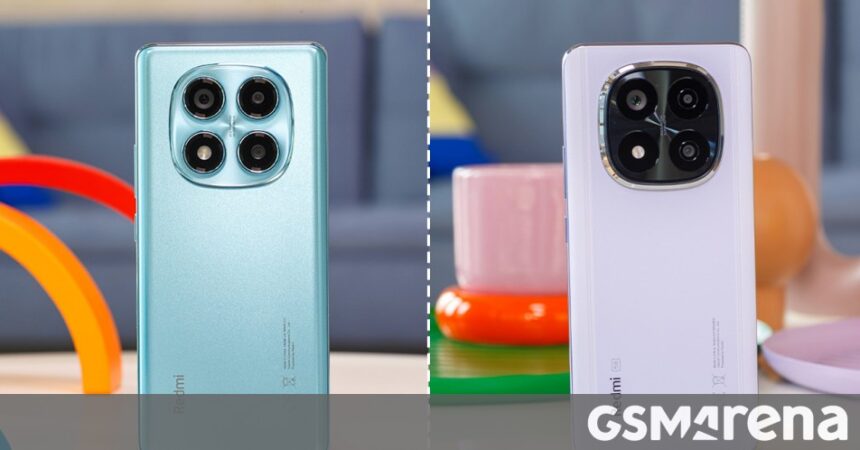You are buying for a mid-range phone in the range of € 200- € 300, and the Redmi Note 14 series clearly offers solid value. Problem? The lineup is full of similar models in confusion -some are also limited to 4G.
We also understand how Ziomi Redmi Note 14 Pro 5G (Global) and Ziomi Redmi Note 14 Pro+ 5G (Global) can compare. Price distance is minimal, and their spec sheets are almost the same.
It is really valuable to spend an additional € 50- € 60 for the Plus version – or if the Standard Pro completes your needs nicely, we are here for the figure.
Table of contents:
For beginners, you can compare the full specs sheets or continue directly with the assessment of our editor In the following text.
Size comparison
The Redmi Note 14 Pro and Pro+ have very similar dimensions, with a little ga ER and heavy chassis later, possibly due to the difference of material material. If not vegan leather, the plus model gives you the glass back instead of plastic.
But for the most, you don’t feel any difference and that’s not surprising. It shows both the same 6.67-inch display. In any case, you will get more premium build with plus.
Comparison
Two redemies show the same display panels. We have not even found any difference in our size. Both devices grow around 1,200 NIT Maximum brightness.
B Battery Terry Life
Both handsets provide the same battery life, which is provided to the shared hardware – the same display and the same 5,110 mAh cells. The only difference is the chipset, and the Redmi Note 14 Pro inside the DIME 73. Ultra looks a bit more efficient. Non-Plus Pro Model Dell Q Call l, gives a Pro+ edge in web and video tests, one gets an extra hour Score active use.
Preaching
The charging rate is probably the most significant difference between two redemies. Pro+ gives a faster 120W charging, completing the full charging cycle within 21 minutes.
Non-plus is replenished by about half of its battery charge at that time, and it takes more than an hour to complete the full charge.
Chair
There is no detectable difference in loudspeaker’s tuning and volume with our contenders. You get the right speakers with both phones with “good” volume.
Operation
Naturally, the Redmi Note 14 Pro+ runs on the more powerful chipset, Snapdragon 7S General 3, while the non-plus dementia 7300 settles for the Ultra SOC. Both chipsets fall into the mid-range segment. But while Snapdragon is more powerful in both, deciding by the battery endurance of the Redmi Note 14 Pro, dementia silicone is obviously more effective.
The memory configurations are quite the same. Both phones start at 8 GB/256 GB and go up to 12 GB/512 GB. In both cases, storage chips are UFS 2.2, and there is no microSD card slot.
Benchmar
In terms of raw performance, Redmi Note 14 Pro+ CPU-Bound Benchmark tests lead by Redmi Note 14 Pro 11% and only 9% in a combined workload like Antutu 10. However, according to the 3 Dimark Wildlife Extreme Benchmark test, which is mainly GPU-intensive, plus varied outperforms, which is a significant gap, which is 24%. So for the gamers there, Pro+ can be a better option.
Camera comparison
Two redemies shares the same camera hardware with a solid 200MP main camera, supported by an 8MP ultravide unit and 2MP macro shooter. The selfie camera uses a 20MP sensor.
Should there be a significant difference in image quality or rendering style, it is due to the potential ISP. There is the same difference in this equation.
The quality of the image
As expected, both devices deliver the same camera quality. There is no meaningful difference in terms of sharpness, clarity and detail. However, there is a slight difference in rendering. For example, non-plus produces hot and potentially more convenient images. The color temperature looks more accurate with a warm color, while the pro+ scenes render the scenes cold.








Redmi Note 14 Pro: 0.6x • 1x • 2x • 4x • 0.6x • 1x • 2x • 4x








Redmi Note 14 Pro+: 0.6x • 1x • 2x • 4x • 0.6x • 1x • 4x
In addition, non-plus provides a wide dynamic range and the handles highlight better. Ultravide cameras are not always the same, however, where two phones are traded. Sometimes Pro+ gets exactly exactly, sometimes non-valid.
It is difficult in low-light scenarios, though. The non-plus model produces a nice ultravide photos with better sharpness, detailed and dynamic range. This applies to 2x and 4x zoom modes. However, as far as 1x photo mode is concerned, intense images with Pro+ output cleaner, more natural shadows and more balanced highlights.








Redmi Note 14 Pro: 0.6x • 1x • 2x • 4x • 0.6x • 1x • 2x • 4x








Redmi Note 14 Pro+: 0.6x • 1x • 2x • 4x • 0.6x • 1x • 4x
Two phones produce the same selfie, but non-plus always offers a slightly wide dynamic range.


Selfie: Redmi Note 14 Pro • Redmi Note 14 Pro+
Video quality
Below we have a few framagrabs taken by two phones taken by two phones at each central length, so it’s easier to compare one another.
Non-plus provides nice videos with more accurate exposure and cleaner overall footage. Ultravide video on non-plus has significant details in both day and night.






Redmi Note 14 Pro 4K Frame Grabs: 0.6x • 1x • 2x • 0.6x • 1x • 2x






Redmi Note 14 Pro+ 4K Frame Grabs: 0.6x • 1x • 2x • 0.6x • 1x • 2x
Judgment
Although Pro+ is marketed as a high-level phone with more premium features, it is not a better phone for most users. Redmi Note 14 Pro and Redmi Note 14 Pro+ similar hardware, such as displays, battery capacity and cameras, but non-plus tops to top in many categories, though they are cheaper.
For example, the Standard Pro offers a slightly long battery life and overall better camera experience (with a few exceptions). It also matches the plus in the display and loudspeaker section.
Pro+, on the other hand, compensates for a slightly lower battery endurance from the blazeing-fast charging, flagship-level. The handset also posts high GPU benchmark scores and provides more premium build (if you go for a glass back version).
But mostly, these phones are very close to brother -sister, suggesting such a name, so at the end of the day, you will pay an extra € 50 for fast charging and small performance benefits and it is up to you to decide what the features are right for you.

- A large amount of similar user experience.
- A little longer battery life.
- A little good camera experience.
- Lower Price Tag
Ziomi Redmi Note 14 Pro 5G (Global) Get:

- More powerful chipset.
- Fast charging.
- More premium build.






